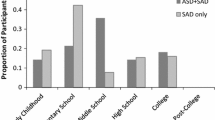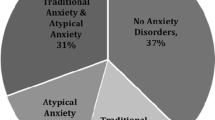Abstract
Within the light of the DSM-5, the current study examined (1) how many and which children with a DSM-IV classification of autism spectrum disorder (ASD) fulfill the DSM-5 symptom-criteria, and (2) whether children who did and did not meet DSM-5 symptom-criteria and children with social anxiety disorder (SAD) can be differentiated from each other based on ASD symptomatology. In total, 90 referred children with a DSM-IV classification of high-functioning ASD, and 21 referred children with SAD participated (age range 7–17 years). ASD-symptoms were examined with the Autism Diagnostic Interview-Revised and the Children’s Social Behavior Questionnaire. It was found that 30 % of the ASD sample did not meet DSM-5 symptom-criteria for ASD, mainly because they failed to meet the DSM-5 criteria of the repetitive domain. Children with ASD who did and did not meet DSM-5 symptom-criteria differed on the repetitive domain, while children with ASD (according to DSM-IV and DSM-5 symptom criteria) had higher scores on the social-communication domain than children with SAD. Findings suggest a continuum of ASD-symptoms in the DSM-5 for children with SAD, social communication disorder and ASD. More research is needed to examine how these three disorders differ with respect to their etiology, neuropsychological profiles and clinical characteristics.
Similar content being viewed by others
References
American Psychiatric Association (2013). Diagnostic and statistical manual of mental disorders, fifth edition. Arlington, VA: American Psychiatric Association.
Frazier, T. W., Youngstrom, E. A., Speer, L., Embacher, R., Law, P., Constantino, J., et al. (2012). Validation of proposed DSM-5 criteria for autism spectrum disorder. Journal of the American Academy of Child and Adolescent Psychiatry, 51, 28–40.
Gibbs, V., Aldridge, F., Chandler, F., Witzlsperger, E., & Smith, K. (2012). Brief report: An exploratory study comparing diagnostic outcomes for autism spectrum disorders under DSM-IV-TR with the proposed DSM-5 revision. Journal of Autism and Developmental Disorders, 42, 1750–1756.
Hartley, S. L., & Sikora, D. M. (2009). Which DSM-IV-TR criteria best differentiate high-functioning autism spectrum disorder from ADHD and anxiety disorders in older children? Autism, 13, 485–508.
Hartman, C. A., Luteijn, E., Serra, M., & Minderaa, R. B. (2006). Refinement of the Children’s Social Behavior Questionnaire (CSBQ): An instrument that describes the diverse problems seen in milder forms of PDD. Journal of Autism Developmental Disorders, 36, 325–342.
Hrdlicka, M., & Dudova, I. (2013). Controversies in autism: Is a broader model of social disorders needed? Child and Adolescent Psychiatry and Mental Health, 7, 1–9.
Huerta, M., Bishop, S. L., Duncan, A., Hus, V., & Lord, C. (2012). Application of DSM-5 criteria for autism spectrum disorder to three samples of children with DSM-IV diagnoses of pervasive developmental disorders. American Journal of Psychiatry, 169, 1056–1064.
Lord, C., Rutter, M., & Le Couteur, A. (1994). Autism Diagnostic Interview-Revised: A revised version of a diagnostic interview for caregivers of individuals with possible pervasive developmental disorders. Journal of Autism and Developmental Disorders, 24, 659–685.
Luteijn E., Minderaa R., & Jackson S. (2002). Vragenlijst voor Inventarisatie van Sociaal gedrag bij Kinderen, Handleiding. Swets & Zeitlinger, Lisse (Questionnaire of social behaviour in children, manual).
Risi, S., Lord, C., Gotham, K., Corsello, C., Chrysler, C., Szatmari, P., et al. (2006). Combining information from multiple sources in the diagnosis of autism spectrum disorders. Journal of the American Academy of Child and Adolescent Psychiatry, 45, 1094–1103.
van Steensel, F. J. A., Bögels, S. M., & Dirksen, C. D. (2012). Anxiety and quality of life: Clinically anxious children with and without autism spectrum disorders compared. Journal of Clinical Child and Adolescent Psychology, 41, 731–738.
van Steensel, F. J. A., Bögels, S. M., & Wood, J. J. (2013). Autism spectrum traits in children with anxiety disorders. Journal of Autism and Developmental Disorders, 43, 361–370.
Author information
Authors and Affiliations
Corresponding author
Rights and permissions
About this article
Cite this article
van Steensel, F.J.A., Bögels, S.M. & de Bruin, E.I. DSM-IV Versus DSM-5 Autism Spectrum Disorder and Social Anxiety Disorder in Childhood: Similarities and Differences. J Child Fam Stud 24, 2752–2756 (2015). https://doi.org/10.1007/s10826-014-0078-2
Published:
Issue Date:
DOI: https://doi.org/10.1007/s10826-014-0078-2




